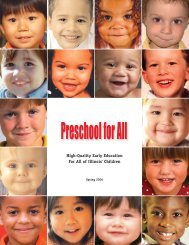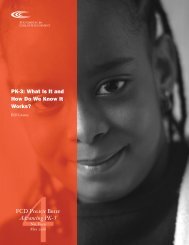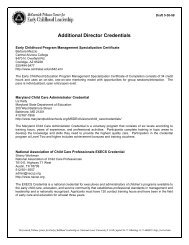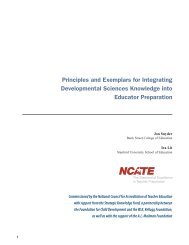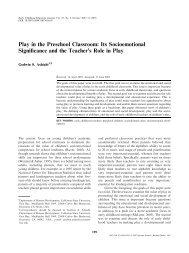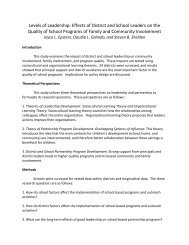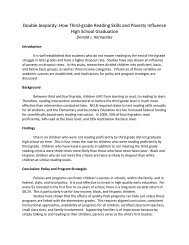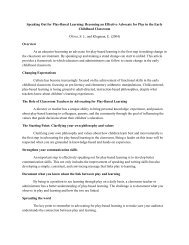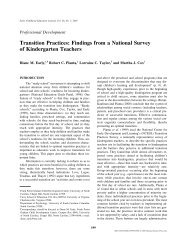Child Outcome Standards in Pre-K Programs - National Institute for ...
Child Outcome Standards in Pre-K Programs - National Institute for ...
Child Outcome Standards in Pre-K Programs - National Institute for ...
You also want an ePaper? Increase the reach of your titles
YUMPU automatically turns print PDFs into web optimized ePapers that Google loves.
<strong>Pre</strong>school Policy Brief March 2004How Many <strong>Standards</strong>?One of the criticisms of K-12 standards has been the sheernumber of standards and benchmarks. Accord<strong>in</strong>g to aconservative estimate, it takes an average of five hours tocover one content benchmark. Address<strong>in</strong>g all standards andbenchmarks identified by states and districts would requireK-12 systems to become K-22 systems! 17Early childhood educators and policy makers should identifya reasonable set of expectations and outcomes that aremean<strong>in</strong>gful and represent the critical learn<strong>in</strong>g necessary<strong>for</strong> later development.3<strong>Standards</strong> should be comprehensive.<strong>Standards</strong> should cover the full range of knowledge, skills,habits, attitudes, and dispositions that children need tomaster. They should encompass all of the major branchesof knowledge that contribute to children’s capacity toreason, create, communicate, solve problems, and ma<strong>in</strong>ta<strong>in</strong>their health. 13 Comprehensive standards <strong>in</strong>clude contentstandards (def<strong>in</strong><strong>in</strong>g the range of knowledge and skillsthat children should master) and per<strong>for</strong>mance standards(def<strong>in</strong><strong>in</strong>g how it can be demonstrated that children havemet the standards).For preschoolers… To be comprehensive, outcomestandards must take <strong>in</strong>to account the five doma<strong>in</strong>s of schoolread<strong>in</strong>ess identified by the <strong>National</strong> Education Goals Panel. 14,1• Physical well-be<strong>in</strong>g and motor development• Social and emotional development• Approaches toward learn<strong>in</strong>g• Language development• Cognitive and general knowledgeYoung children’s learn<strong>in</strong>g is heavily dependent on thedevelopment of language, th<strong>in</strong>k<strong>in</strong>g, and cognitive andsocio-emotional skills that are taken <strong>for</strong> granted <strong>in</strong> highergrades where the primary emphasis is placed on content.In early childhood, the development of these foundationalskills (skills that lay the foundation <strong>for</strong> later learn<strong>in</strong>g) is justas important as mastery of content matter. For example,there is a grow<strong>in</strong>g body of evidence <strong>in</strong>dicat<strong>in</strong>g that cognitiveand emotional self-regulation play a key role <strong>in</strong> <strong>in</strong>fluenc<strong>in</strong>grates of learn<strong>in</strong>g and school read<strong>in</strong>ess. 15,16 For preschoolers,standards that address foundational skills should there<strong>for</strong>ebe articulated with as much specificity as the contentstandards.4<strong>Standards</strong> should be specific, yet still allowflexibility as teachers implement them.If a standard covers a broad area of learn<strong>in</strong>g or developmentit must to be broken down <strong>in</strong>to more narrow benchmarks.However, the benchmarks should not be too specificto allow <strong>for</strong> teachers’ flexibility <strong>in</strong> implement<strong>in</strong>g differentcurricula or us<strong>in</strong>g different <strong>in</strong>structional strategies. Forexample, a benchmark that says: “retells from memory afamiliar book about farm animals” appears overly specific.For preschoolers… In some areas, the lack of specificitythat can weaken standards <strong>for</strong> older students can alsounderm<strong>in</strong>e preschool standards. There is a particularlystrong need <strong>for</strong> specificity as standards and benchmarksare written <strong>for</strong> preschool language and literacy development.18 As one recent study observed, “age appropriate andwell-written clear benchmarks have a crucial role <strong>in</strong> br<strong>in</strong>g<strong>in</strong>geffective literacy practices to preschool programs.” 19<strong>Pre</strong>school outcomes need to be stated <strong>in</strong> terms of skills,rather than activities.In other areas of early learn<strong>in</strong>g, the requirement of specificitycan be problematic because many of young children’s competenciesare develop<strong>in</strong>g <strong>in</strong> concert. It is often difficult toisolate learn<strong>in</strong>g outcomes <strong>in</strong> a s<strong>in</strong>gle area. It is often betterto describe a learn<strong>in</strong>g outcome <strong>in</strong> a way that is specific to aparticular doma<strong>in</strong> of development, even if that meansrepeat<strong>in</strong>g the standard (perhaps with different emphasis)as it relates to another doma<strong>in</strong>. This will help teachers tobetter focus on the outcome of a child’s learn<strong>in</strong>g <strong>in</strong>choos<strong>in</strong>g appropriate assessments, materials and activities.For example, while be<strong>in</strong>g able to participate <strong>in</strong> dramaticplay is a learn<strong>in</strong>g outcome that comb<strong>in</strong>es a young child’sachievements <strong>in</strong> the areas of socio-emotional, cognitive,and language development, support<strong>in</strong>g each of these areaspresents teachers with different demands <strong>in</strong> terms ofassess<strong>in</strong>g child per<strong>for</strong>mance or plann<strong>in</strong>g <strong>in</strong>structional<strong>in</strong>terventions.What Are Benchmarks?<strong>Standards</strong> are often broken down <strong>in</strong>to more specificbenchmarks that can be demonstrated and measured.An example: “Develops personal and social competence”is a standard whose aim is clarified by the benchmark,“Listens to others and participates <strong>in</strong> group ef<strong>for</strong>ts.”5




